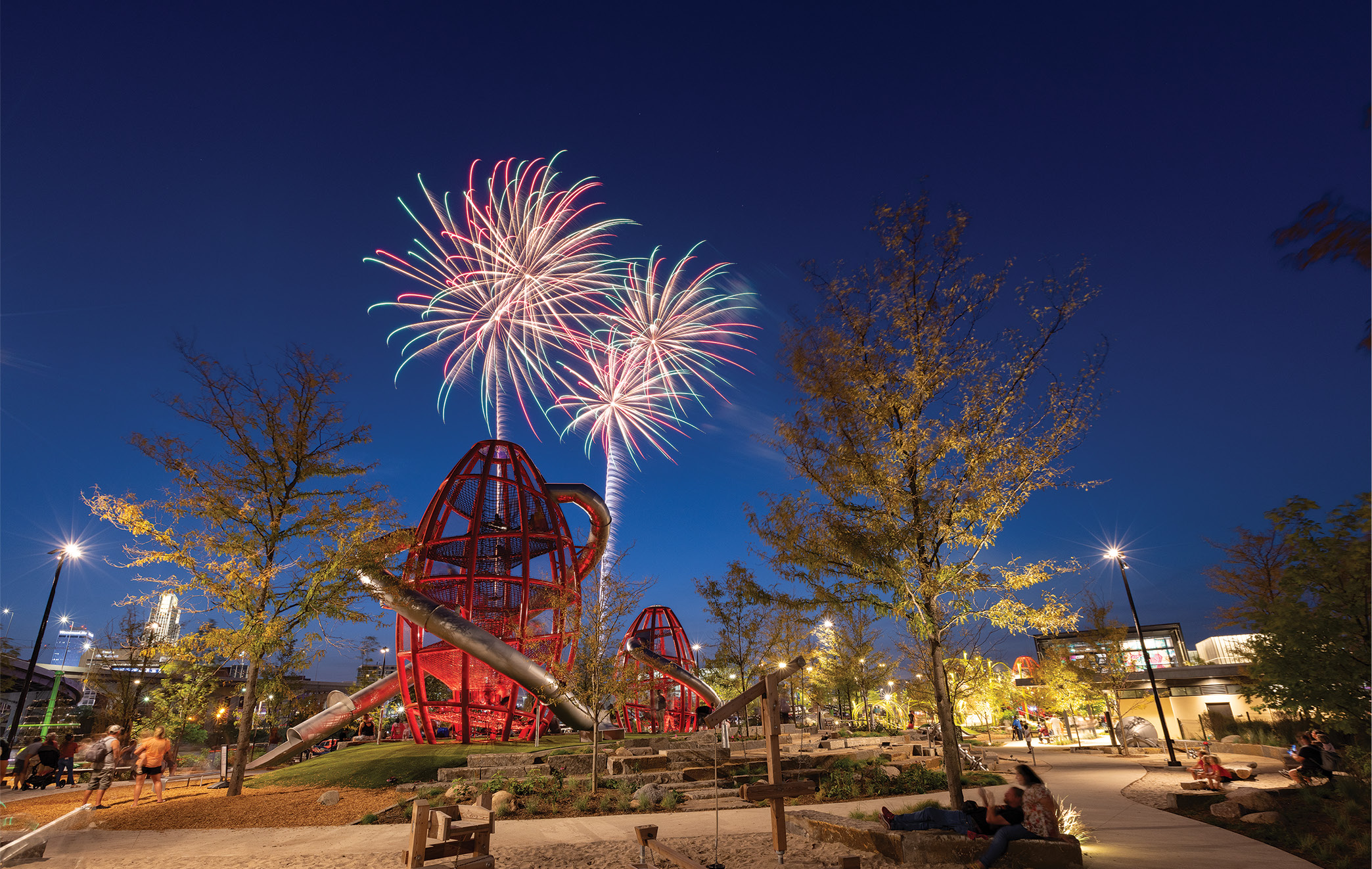The exact date isn’t clear, but about 10 years ago two high-powered Omaha business leaders paid a call on the city’s new mayor, Jean Stothert, to make an audacious request. Would she back their vision to remake and re-enliven 70 city-owned acres, mostly decrepit, in a bid to lure Omahans and visitors to the Missouri River?
“I think it took maybe 30 seconds before the mayor said, ‘It’s a great idea,’ ” remembers businessman and philanthropist Ken Stinson, former chairman of Kiewit Corporation, Omaha’s go-to firm for major construction projects. “She said right away that she wanted to be part of it.”
Fast forward to August 18, 2023, and fireworks flew over Omaha’s dynamic, new RiverFront, three connected parks that have since drawn more than a half million visitors to a part of town recently frequented more often by homeless people. It’s been hailed by the American Society of Landscape Architects as “gracefully dividing the land into meaningful spaces,” with “grand gestures that are well-scaled, highly social and memorable.”
A “game changer” is how Mayor Stothert described the RiverFront in an interview in late September.
“It is world class and it’s transformational,” Stothert tells Site Selection. “Great cities have great parks. Omaha is a great city, and this is a great park that can be used by everyone.”
Together, Omaha’s new Gene Leahy Mall, Heartland of America Park and Lewis and Clark Landing complete a “Return to the River” concept pursued in fits and starts by Omaha for half a century or more, something Stinson views as a long-term dream to “recapture” prime riverfront property from industrial users.
“I’ve been in the construction business 50-plus years and I’ve gone through lots of projects, and this one was personal,” Stinson tells Site Selection. “The social impact on the city has been incredible. If you go to the park now or at 10 o’clock tonight, you will see a very diverse population there. Lot of people who wouldn’t otherwise come together.”
Private Money Culture
In fundamentally Omaha fashion, when the hat got passed to fund the project, private donors filled it. With fundraising led by Stinson and fellow philanthropist Mogens Bay, former CEO of Omaha’s Valmont Industries, the private sector would pony up a whopping $400 million toward the realization of the RiverFront parks. The city has chipped in about $60 million.
“We knew,” says Stinson, “that this had to be a public-private partnership with most of the money coming from philanthropy. There is a lot of institutional wealth in Omaha, but we also knew that philanthropy would expect that the city would be a significant player.”
It started with $50 million pledges each from Omaha’s Berkshire Hathaway, Sherwood Foundation, Robert Daugherty Foundation and Suzanne & Walter Scott Foundation. Hundreds of other privates followed the lead.
The template isn’t new. Private support channeled $75 million toward Omaha’s $291 million Arena Convention Center; put $43 million toward the $140 million price tag of Charles Schwab Field, which hosts the College World Series; fully funded the $100 million Holland Performing Arts Center and, more recently, Omaha’s $100 million Steel House concert hall.
“The public-private relationship that Omaha has is very, very unique and it’s something that makes us great,” says Stothert. “That private support helps us do things we could never do on our own. What I hear all the time,” she says, “is philanthropy will get involved but they want the city to have skin in the game. And when philanthropy puts money in, they expect something out of it.”
New Development Blossoms
As its supporters had hoped, the RiverFront is catalyzing development. Just west of the Gene Leahy Mall, Mutual of Omaha is building a $600 million, 44-story headquarters that will be the tallest building for several states over. In June, officials cut the ribbon nearby on The Brickline, the first phase of a 20-acre mixed-use development called The Mercantile. An aging, boutique hotel has been revamped and other living options are going in.
“We are always looking at how we are going to bring more businesses and professionals in,” says Stother. “They’re looking for urban living, affordable housing, public transportation, walkability, parks and entertainment, and that’s exactly what we’re doing.”
The next big step in that direction is Omaha’s $356 million streetcar project. Fully funded by the city, free to riders and expected to begin construction next summer with a 2027 delivery date, the project, Stother believes, “will add to the transformation of downtown,” connecting parts of the city that are already growing.
“Half of downtown right now is surface parking,” says Stothert. “So, what we are doing is trading parking for business and for residential. We have all these great venues, but you can’t get from one to another without getting in your car. The streetcar,” she says, “will bring it all together.”

